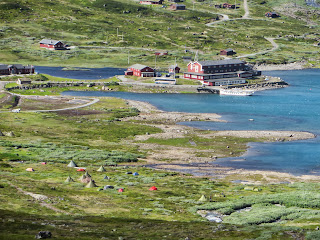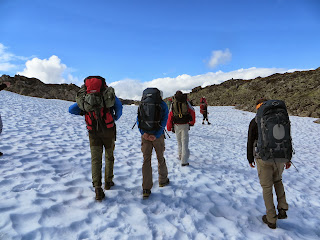This summer, my brother and I went on a
six day hike through the Jotunheimen National Park in Norway. Although I have done plenty of bushwalking in the past, this 6 day tour organised by the Norwegian Trekking Association (
DNT) is the first multi-day trek I have done. Over 25 hours of walking, we covered almost 60km of pretty incredible Norwegian terrain, and even though I was pretty tired and sore by the end of it, I found it an incredible experience and will hopefully do something similar again soon.
 |
| Lake Gjende, approaching Gjendebu |
Approximate starting and ending points of our hike
We were above the treeline so the land was sparse, covered in dull brown and greens. Even high above see level, there were lakes sitting in the valleys between the peaks. In places all we could see in every direction was rocks. With the grey sky above giving it felt like we were on a different planet, or on set in a sci-fi movie. In other places, snow covered peaks dropped steeply into bright blue water, while in others we walked along beside rushing water filling deep gorges in the mountain and looked across wide, sparkling lakes fed by waterfalls which ran like white snakes down the sides of the mountains.
 |
| Waterfall approaching Fondsbu |
 |
| Lake Gjende, Gjendebu cabins |
Norway takes full advantage of the beautiful scenery by making it very practical for walkers to visit. The tracks are fairly well marked, and we were constantly keeping our eyes open for the next pile of stones painted with a bright red 'T'. There is a network of self-service cabins spread through the national park which means you don't need to bring a tent and sleeping gear, or food and cooking equipment. This makes it possible to travel with a lighter pack and makes the walk much easier, and much more comfortable to have a roof over your head in the freezing rain compared to sleeping in a tent. But more on that later.
 |
| Tomashelleren |
 |
| Crossroads at Fondsbu |
 |
| Watch for the red 'T' |
 |
| Yksendalsbu |
Nathan and I flew in to Oslo on Friday night, staying in a hotel a short bus ride from the airport. We started early on Saturday morning so that we could meet our tour group leader at Oslo Central station, from which we had a four hour bus ride North West from Oslo. The final leg was a private shuttle which took us out into the mountains. As we approached one mountain I jokingly remarked it would be funny if we had to go up that, and I was a bit surprised when that is exactly what we did. There was no easy introduction as we headed straight up the face of the mountain.
As we approached the cabin on the first afternoon, there was a herd of reindeer playing on the snowfields on the other side of the lake. The older, larger reindeer walked slowly through the snow as some of the younger ones chased each other, slipping and sliding down the hill towards the water. Later that evening we saw a herd of reindeer through the window of our cabin, as they passed within a hundred metres of us.


The conditions were constantly changing to give new challenges as we walked through the mountains. After an hour of steep ascent my legs would be ready for a rest, but after a while descending on the other side I was ready to start up hill again to reduce the pressure on my toes and calves. Balancing on sharp edges as we worked our way through the fields of rocks required great concentration, but after an hour of squishing through ankle deep mud I was happy to take any solid object I could put my feet on. To start with, I was quite slow making my way through the rocky, slippery terrain, especially trying to get used to the affect of the large pack on my back. Through the week, I became more confident and sure footed, better at picking spots to place my feet and how to hold my weight to stay properly balanced.
 |
| Leaving Gjendebu |
Our group of 12 people was an interesting mix ages, experience levels and nationalities. Everyone spoke at least some English, although Nathan and I were the only native English speakers, with the others speaking Norwegian and Danish (which are apparently similar enough that they understand each other) and some Dutch. There was a few people at or approaching retirement age who were very experienced and had interesting stories of hikes they had done all over the world. I will be very pleased if I am able to keep up with a week long trek like this when I am that age.
 |
| Entertainment while waiting for the boat |
On our second day, I experienced my first river crossing. From a distance the river did not look particularly intimidating. Up close though, the water was deeper and faster than it looked, and the rocks beneath the surface were sharp, slippery and unsteady. In warmer conditions and without all our packs, it would have been possible to splash straight through without much care, but it was important to keep as dry and warm as possible. Some of the people in our group were well prepared with walking poles for balance and sandals to protect their feet. Those of us without this equipment went barefoot, with trousers and sleeves rolled up. Nathan borrowed a walking pole to help cross over, but when he tried to throw it back over for me to use, it didn't quite make it all the way. We watched with dismay as it got caught in the current and floated off down the river. Eventually we all made it across, dried off, redressed and carried on. There was one other smaller river crossing, but all the others had nice, dry bridges over them.
 |
| Crossing the river, the hard way |
 |
| Crossing the river, the easy way |
The network of cabins provided by the DNT made it almost luxurious to stay out in the mountains. At the end of each day, tired, sore, cold, sometimes soaking wet, it was always a great sight when the cabins appeared in the distance. They were a ways located close to a lake, which is important for the self service cabins as we need to collect our own water for drinking and cooking. The first night was at Tomashelleren and the second at Yksendalsbu, both self service cabins. There were always 2 cabins on site so if one burnt down there would be a second kept safe for arriving walkers. It is not possible to book these huts so potentially there could be more people than beds, but fortunately we didn't have any issues.
 |
| Tomashelleren |
 |
| Yksendalsbu |
 |
| Bedroom/bathroom/storage room/drying room |
The cabins were well set up with bunk beds, an eating area, gas stove and cooking equipment, wood stoves for warming and drying, and toilets. Upon arrival we split up the jobs of bringing buckets of water up from the lake, cooking, chopping firewood, cooking and cleaning. It is important to keep the cabins in good condition because they are difficult to access and only infrequently visited for maintenance.



There was also a food room which was stocked with non-perishable items. We ate packet soups, pasta with packet sauce, tinned meats and dehydrated potato. There was tinned fruit for dessert, porridge for breakfast, and cracker breads with various spreads which we packed for lunches. It worked on an honour system where you would fill out a form with your payment details and the food you ate, and leave it at the cabin. It was maybe 10 or 15 euro per day for plenty of food, and although it was not exactly gourmet, it was nutritious and much easier than carrying a week's worth of food each in our packs.
 |
| Cooking dinner |
The serviced cabin were a different story altogether. We stayed two nights at Fondsbu, and a single night at Gjendebu. We stayed in dormitories with electricity and hot water- the showers were very welcome by this point. One unexpectedly welcome feature of these sites was the drying room, where wall length heaters cranked up the temperature to quickly dry out all the clothes and shoes that had been hung out by all the walkers who arrived after long days out in the wet.
 |
| Fondsbu |
 |
| Dorms at Fondsbu |
 |
| Drying room at Fondsbu |
 |
| Cabins at Gjendebu |
 |
| View of Lake Gjende from our bedroom window |
Dinner was a three course buffet shared by everyone in the large restaurant dining hall. Before dinner on our first night in Fondsbu the hostess sang a medieval Norwegian folk song about a princess and a nightingale which was a unique dining experience. The dining rooms were quite full as both sites had road access, which means they were used as the starting/ending points of multi-day walks, or the base for day walks. On our spare day at Fondsbu, some of us from our group did a day walk up one of the nearby mountains. Unfortunately it was quite wet and there was not much to see because of the thick could, but it was was nonetheless.
 |
| Reaching the top of our walk from Fondsbu |
One night we had
wolffish for dinner which the Norwegians seemed to be quite happy about. Other Norwegian foods we ate included a purple jam sauce made from local berries, and a delicious brown cheese made from caramelised goat milk called
brunost. I really enjoyed this so before leaving Oslo I bought a large block to bring home, along with a cheese slicer which the Norwegians on our group proudly told me was invented by a
Norwegian guy.
 |
| Brunost |
The weather was mostly drizzly and overcast, although at some points it rained quite heavily and others it was blue and sunny. In the mornings it was cool. Even though it was summer it was down to 4 degrees one morning as we left the cabin, although the walking kept us warm enough. The actual temperature meant very little at some places where we went over the peak of a mountain to be hit be incredibly strong winds. I was struggling to walk, and one of the walkers in our group with decades of trekking experience commented that this was the strongest wind they had experienced.
 |
| Departing Yksendalsbu |
On our last day, we walked from Gjendebu to Memurubu, which included a steep ascent that we needed to use chains to pull ourselves up in some sections. From there, we caught a boat to Gjendesheim before repeating the bus ride back to Oslo station.
Here are a few more photos from the hike, and an album containing all the photos.






























































No comments:
Post a Comment